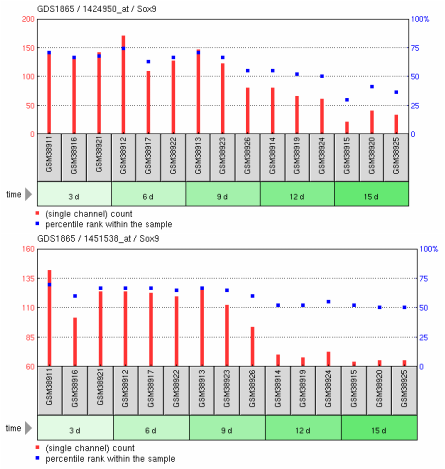Microarrays:
For this module, we looked on the Gene Expression Omnibus to find microarray experiments with our gene of interest (Sox9). Using the search terms "Sox9" and "chondrocyte" gave a huge amount of data to sift through. I eventually found this one from James et al 2005 because they used limb bud mesenchyme cells, which are as close to a physiologically relevant system of chondrogenesis as I could find (others had different cell lines of chondrocytes derived from tumors and ES cells).
Sox9 Microarray

Title: GDS1865 / 1424950_at / Sox9 / Mus musculus
Summary: Analysis of micromass cultures derived from limb bud mesenchymal cells and cultured for 15 days in differentiating conditions (beta-glycerophosphate and ascorbic acid). Cultures examined every 3 days, up to day 15. Results provide insight into the mechanisms regulating chondrocyte differentiation. The data is from James et al 2005.
These experiments demonstrate that Sox9 levels are at the highest during the first 9 days in culture. After Day 9, Sox9 levels decrease, which is an indicator that the chondrocytes in the culture have begun to undergo hypertrophic differentiation, where Sox9 is known to be downregulated (Provot and Schipani 2005).
It is interesting to note that among the myriads of microarray data involved with chondrocyte differentiation and mesenchymal stem cell differentiation, there is no study I am currently aware of that shows a microarray of limb buds undergoing chondrogeneic differentiation in vivo. A very informative experiment would be to isolate limb buds from E12.5 and E14.5 limb buds from wildtype and Sox9 knockout (+/-) mice and to compare the transcriptional profile of these two samples using a microarray.
Summary: Analysis of micromass cultures derived from limb bud mesenchymal cells and cultured for 15 days in differentiating conditions (beta-glycerophosphate and ascorbic acid). Cultures examined every 3 days, up to day 15. Results provide insight into the mechanisms regulating chondrocyte differentiation. The data is from James et al 2005.
These experiments demonstrate that Sox9 levels are at the highest during the first 9 days in culture. After Day 9, Sox9 levels decrease, which is an indicator that the chondrocytes in the culture have begun to undergo hypertrophic differentiation, where Sox9 is known to be downregulated (Provot and Schipani 2005).
It is interesting to note that among the myriads of microarray data involved with chondrocyte differentiation and mesenchymal stem cell differentiation, there is no study I am currently aware of that shows a microarray of limb buds undergoing chondrogeneic differentiation in vivo. A very informative experiment would be to isolate limb buds from E12.5 and E14.5 limb buds from wildtype and Sox9 knockout (+/-) mice and to compare the transcriptional profile of these two samples using a microarray.
References
James CG, Appleton CT, Ulici V, Underhill TM et al. Microarray analyses of gene expression during chondrocyte differentiation identifies novel regulators of hypertrophy. Mol Biol Cell 2005 Nov;16(11):5316-33.
Provot S, Schipani E. Molecular mechanisms of endochondral bone development. Biochem Biophys Res Commun. 2005 Mar 18;328(3):658-65.
Provot S, Schipani E. Molecular mechanisms of endochondral bone development. Biochem Biophys Res Commun. 2005 Mar 18;328(3):658-65.
